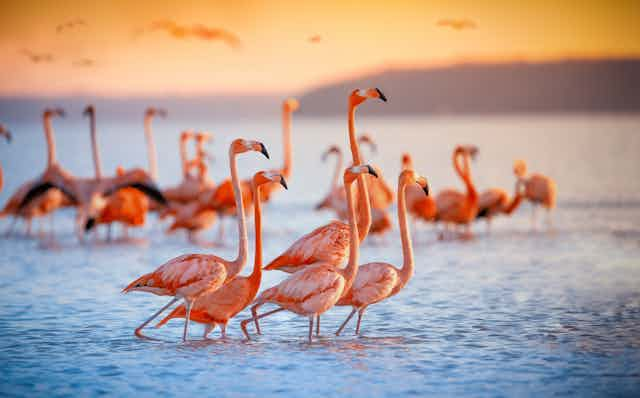The Earth’s surface is splotched with 117 million lakes. Some are scarcely more than ponds, while others are so big they can be seen from space. At 395 miles long, 49 miles wide and just over 1 mile deep, Lake Baikal in Siberia is one of the world’s largest and it’s home to 2,500 species, including the Baikal seal – Earth’s only species of freshwater seal.
Lakes and rivers occupy just 1% of the Earth’s surface but are incredible hotspots for biodiversity, sheltering 10% of all species globally. Particularly in older and deeper lakes, life has had millions of years to evolve and adapt to the peculiarities of that habitat, giving rise to unique forms. But since 1970, numbers of freshwater vertebrates, including birds, fish, amphibians, reptiles and mammals, have declined by a staggering 83% through the extraction of lake water, pollution, invasive species and disease. Now, climate change threatens to drive even deeper losses.
Lake heatwaves – when surface water temperatures rise above their average for longer than five days – are a relatively new phenomenon. But by the end of this century, heatwaves could last between three and 12 times longer and become 0.3°C to 1.7°C hotter. In some places, particularly near the equator, lakes may enter a permanent heatwave state. Smaller lakes may shrink or disappear entirely, along with the wildlife they contain, while deeper lakes will face less intense but longer heatwaves.

In a new study, researchers examined 393 lakes worldwide between 1981 and 2017 and found their temperatures rose by 0.39°C every decade, while dissolved oxygen fell by 5% at the surface and 19% in the depths. It’s in these cooler, deeper parts of lakes where trout, burbot and salmon usually thrive thanks to sufficient oxygen, especially in the summer. Largely due to warming air temperatures, 68% of the lakes in the study had lost this important niche to rising temperatures and falling oxygen levels.
So what do these changes mean for the other forms of life that call lakes home?
How lake life will change
Most organisms that live in lakes can only thrive in water with just the right temperature and concentration of nutrients and oxygen. Warmer lakes hold less oxygen and lose more water through evaporation, forcing species to live in saltier and less oxygenated habitats.
Things won’t be easy for species which live above the water for most of their lives either. Dragonflies are a common sight flitting among the reeds on the lake side. They lay their eggs in the shallows, but as lakes are lowered or dry out during more frequent and severe heatwaves, this protection is lost. Those larvae which survive are likely to emerge early, when food and habitat may be lacking.
Climate change will shift the types of organisms we find in lakes. Cold water fish, such as trout and salmon, need cooler temperatures and higher oxygen concentrations than warm water species such as largemouth bass and white perch. One cold-loving species, Arctic char, could vanish from 73% of its Swedish range by 2100 just as a result of warming. Meanwhile, rising temperatures could mean parasites that infect fish grow faster and larger. In one study, parasitic worms infecting stickleback fish grew four times faster in water at 20°C compared to 15°C.
Heatwaves could accelerate the spread and size of pathogens in fish, with huge consequences for the aquaculture industry and wild populations. Human diseases, transmitted by freshwater organisms, may also increase. Naegleria fowleri is a lake parasite that flourishes in warmer temperatures. Known as the brain-eating amoeba, this microbe can cause fatal meningoencephalitis if it enters the body through the nose. Prolonged periods when lake waters remain warmer than average could see this parasite expand into more temperate waters.
Since warmer surface waters hold more nutrients, climate change could cause an explosion in the number of microscopic algae that live in lakes. These microorganisms are the base of the food web and the foundation of life in these habitats. But this isn’t the good news it seems. When nutrients are abundant, huge quantities of these algae can form a thick green (or sometimes red) blanket on the lake surface. These algal blooms not only look unsightly, they often produce harmful toxins.
Heatwaves are increasing the frequency of harmful algal blooms and causing mass mortality events where thousands of animals die in a few days. Algal blooms block out the light and suffocate fish, either by crashing oxygen levels or clogging up their gills. A 100 metre-wide, 15cm-deep algal bloom in Loch Leven in Scotland in 1992 killed 1,000 brown trout over 24 hours.

Unlike those living elsewhere, most lake animals cannot simply move to another habitat once their lake becomes uninhabitable. But even migratory species will suffer. In August 2004, 15,000 flamingos died on a lake in Tanzania after consuming toxins produced by algal blooms.
As heatwaves proliferate and oxygen levels decline, mass fish die-offs are predicted to double from the 2040s in lakes in the northern hemisphere and increase fourfold in the southern hemisphere from the 2080s onwards. Without immediate action to curb emissions and slow climate change, many of the world’s lakes are on course for a sweltering, breathless and lifeless future.

